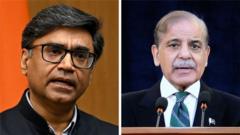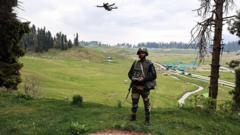On May 10, 2025, India and Pakistan announced a cease-fire following four days of intense military conflict characterized by drone strikes and missile attacks. While the announcement was met with relief, reports of continued hostilities raise concerns over the cease-fire's durability. U.S. involvement in mediating the agreement was acknowledged, with officials from both countries affirming its significance.
Cease-Fire Announced Between India and Pakistan Amid Continued Tensions

Cease-Fire Announced Between India and Pakistan Amid Continued Tensions
After intense fighting that escalated at a record pace, India and Pakistan have declared a cease-fire, yet reports of ongoing violence highlight the fragile nature of the agreement.
In a dramatic development, India and Pakistan confirmed a cease-fire on May 10, 2025, after witnessing one of their most intense military confrontations in decades. The cease-fire follows four days of aggressive hostilities involving drone strikes and missile attacks, which emphasized a dangerous escalation in the long-standing conflict between the two nuclear-armed neighbors.
Indian Foreign Secretary Vikram Misri officially announced the cease-fire, acknowledging that discussions had taken place between officials from both nations. However, there were indications that the cease-fire was not entirely effective as reports of cross-border firing along the Line of Control continued throughout the night. Indian officials confirmed that Pakistani drones had been sighted over the Indian-administered region of Kashmir, which they claimed violated the cease-fire agreement.
The recent hostilities were ignited by a deadly attack in Kashmir last month, which India attributed to Pakistan-based militants. Following intense military exchanges, including strikes on air bases in both countries, U.S. President Donald Trump noted that the cease-fire was a result of extensive mediation by the American administration. Pakistani Prime Minister Shehbaz Sharif expressed gratitude toward the United States for its role in facilitating the cease-fire, indicating a diplomatic acknowledgment of foreign involvement.
Despite the potential for international intervention to promote peace, both nations appear to maintain a level of skepticism. While Pakistan welcomed the diplomatic mediation, India focused on the notion that any agreements should be negotiated solely between the two countries.
The current situation remains tenuous, with global leaders expressing relief over the cease-fire. British Foreign Minister David Lammy called the decision "hugely welcome," urging both nations to prioritize enduring peace, whereas German officials deemed the cease-fire a critical first step in de-escalating tensions. However, historical patterns of violence and mistrust complicate the prospect of maintaining a lasting peace.
As news of the cease-fire spread, some residents in Kashmir expressed relief, eager to return to their homes after fleeing intense shelling. Nevertheless, the specter of renewed violence looms large, with Indian officials asserting that any future acts of terrorism would be interpreted as direct aggression, raising the stakes for the fragile cease-fire.
The recent engagement represented a historic shift in the conflict dynamics between India and Pakistan, marked by the extensive use of drones on both sides. Such developments prompt concerns within international observer communities regarding the evolving landscape of warfare as both nations advance their drone capabilities.
In the immediate aftermath, the global community watches closely, hoping that the cease-fire will hold amidst a backdrop of escalating nationalist sentiments and volatile politics. Yet, as history illustrates, confidence-building measures will be crucial for achieving sustained peace in a region long plagued by conflict.






















